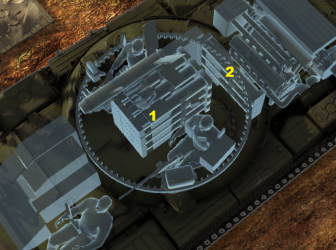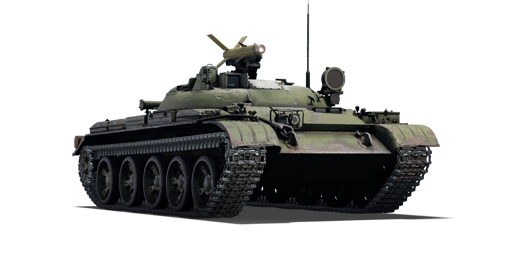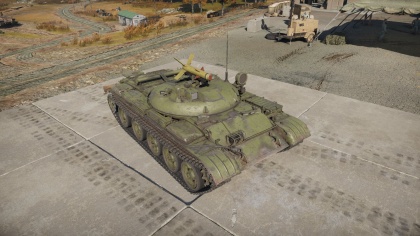Difference between revisions of "IT-1"
Colok76286 (talk | contribs) (→Media: Added video) |
bangerland (talk | contribs) (→Pros and cons: rewrote it to make more sense along ATGM tank logic and overall power balance. also i doubt the ammo rack can still be detonated, but i dunno, really.) |
||
| Line 174: | Line 174: | ||
'''Pros:''' | '''Pros:''' | ||
| − | * Anti-tank missile equipped | + | * Anti-tank missile equipped is slightly faster than ones found on early light tanks |
| − | * Good armour of a [[T-62]] | + | * Good armour of a [[T-62]], will likely survive attempts to simply use HE or even HESH on it, can brawl with a light tank or SPAA, unless they have APDS belts or know all of the weakspots |
| − | * | + | * The turret has even lower profile than usual and is hard to punish for overextension and use of low cover due to its shape and armour value, unlike [[Swingfire]], [[BMP-1]], [[M60A2]] and other alternatives |
| − | + | * Layout of the hull makes direct hits from the front easier to survive, for example, randomly firing ATGM at it may result in a hit to the fuel tank and not destroy IT-1, but set it on fire instead | |
| − | + | * Relatively fast reload on any crew | |
| − | |||
| − | * Layout of hull makes direct hits | ||
'''Cons:''' | '''Cons:''' | ||
| − | * No | + | * No backup weapons, only one type of missiles, low penetration power like early ATGMs, missiles reload slower than conventional tanks and tank can only use one per reload, which makes it overall less forgiving than other ATGM tanks in direct fight |
| − | + | * Missile on the top of the turret is an ammo rack and can be detonated. Optics to the right of it, while hard to hit, can also be exploited to push explosives inside of the tank if operator does not move around, so IT-1 is not invincible even when in cover | |
| − | * Missile on turret is an ammo rack, can be | + | * Movement speed of this tank is less than average - it can't chase or run from many rank VI tanks and may be forced to fight light tanks for its sniping spots |
== History == | == History == | ||
Revision as of 14:26, 1 October 2020
Contents
Description
The IT-1 is a rank VI Soviet tank destroyer
with a battle rating of 8.7 (AB/RB/SB). It was introduced in Update 1.59 "Flaming Arrows" and was one of the first ATGM-equipped vehicles to be in the game. The IT-1 is equipped with the 3M7 anti-tank missile capable of penetrating 500 mm.
General info
Survivability and armour
Armour type:
- Rolled homogeneous armour (Hull)
- Cast homogeneous armour (Turret)
| Armour | Front (Slope angle) | Sides | Rear (Slope angle) | Roof |
|---|---|---|---|---|
| Hull | 100 mm (60°) Front glacis 100 mm (55°) Lower glacis |
80 mm | 45 mm (1-2°) Upper 45 mm Lower |
30 mm |
| Turret | 200 mm (19-60°) | 120 mm (23-61°) | 65 mm (21-56°) | 30 mm |
| Armour | Sides | Roof | ||
| Cupola | 40 mm | 40 mm |
Notes:
- Suspension wheels are 20 mm thick, tracks are 18 mm thick
Mobility
| Game Mode | Max Speed (km/h) | Weight (tons) | Engine power (horsepower) | Power-to-weight ratio (hp/ton) | |||
|---|---|---|---|---|---|---|---|
| Forward | Reverse | Stock | Upgraded | Stock | Upgraded | ||
| Arcade | 55 | 9 | 34.5 | 899 | 1,107 | 26.06 | 32.09 |
| Realistic | 51 | 8 | 513 | 580 | 14.87 | 16.81 | |
Armaments
Main armament
| 3M7 missile | Turret rotation speed (°/s) | Reloading rate (seconds) | |||||||||||
|---|---|---|---|---|---|---|---|---|---|---|---|---|---|
| Mode | Capacity | Vertical | Horizontal | Stabilizer | Stock | Upgraded | Full | Expert | Aced | Stock | Full | Expert | Aced |
| Arcade | 15 | -9°/+17° | ±180° | Two-plane | 22.0 | 31.5 | 37.0 | 40.9 | 43.5 | 10.0 | 10.0 | 10.0 | 10.0 |
| Realistic | 14.8 | 21.3 | 21.3 | 23.5 | 25.0 | ||||||||
Ammunition
| Penetration statistics | |||||||
|---|---|---|---|---|---|---|---|
| Ammunition | Type of warhead |
Penetration @ 0° Angle of Attack (mm) | |||||
| 10 m | 100 m | 500 m | 1,000 m | 1,500 m | 2,000 m | ||
| 3M7 | ATGM | 500 | 500 | 500 | 500 | 500 | 500 |
| Shell details | |||||||||
|---|---|---|---|---|---|---|---|---|---|
| Ammunition | Type of warhead |
Velocity (m/s) |
Projectile Mass (kg) |
Fuse delay (m) |
Fuse sensitivity (mm) |
Explosive Mass (TNT equivalent) (g) |
Ricochet | ||
| 0% | 50% | 100% | |||||||
| 3M7 | ATGM | 224 | 54.0 | N/A | 0.1 | 2,520 | 80° | 82° | 90° |
Ammo racks

| Full ammo |
1st rack empty |
2nd rack empty |
Visual discrepancy |
|---|---|---|---|
| 15 | 4 (+11) | 1 (+14) | No |
Notes:
- Missiles are modeled individually and disappear once shot/loaded.
Machine guns
| 7.62 mm SGMT | ||||
|---|---|---|---|---|
| Mount | Capacity (Belt capacity) |
Rate of fire (shots/minute) |
Vertical guidance |
Horizontal guidance |
| Coaxial | 2,000 (250) | 600 | -6°/+17° | N/A |
Usage in battles
Gameplay summary:
The IT-1 is a niche modification of the T-54/55 chassis to carry an ATGM, which puts it at a disadvantage in most situations. While the 3M7 ATGM has high penetration, it travels slower than conventional rounds, must be guided all the way to the target, and cannot be fired on the move. These qualities mean that the 3M7 is inferior to a conventional cannon in most respects, however it is useful when used behind cover. Being that the 3M7 is elevated above the turret, the best strategy is to use hull down cover and guide the 3M7 to targets, exposing only the top of the turret.
Close Range Engagements:
The IT-1 is substantially outclassed in close range engagements. The ATGM is inferior at close range to conventional guns, and the armour, while thick, is unlikely to stop most enemy fire at close range. The best strategy is simply to try and avoid close range confrontations.
Long Range Engagements:
The IT-1 performs best at long ranges while behind cover. The ATGM will easily dispatch of most enemy vehicles, and the IT-1 is very difficult to kill when it uses cover effectively. However, keep in mind that the 3M7 ATGM is not particularly fast, so enemies may have time to retreat to cover before it reaches them. If an enemy is pushing towards your cover and a retreat is needed, the ESS can come in handy.
Modules
| Tier | Mobility | Protection | Firepower | |
|---|---|---|---|---|
| I | Tracks | Parts | Horizontal Drive | |
| II | Suspension | Brake System | FPE | |
| III | Filters | Crew Replenishment | Elevation Mechanism | |
| IV | Transmission | Engine | ESS | NVD |
Pros and cons
Pros:
- Anti-tank missile equipped is slightly faster than ones found on early light tanks
- Good armour of a T-62, will likely survive attempts to simply use HE or even HESH on it, can brawl with a light tank or SPAA, unless they have APDS belts or know all of the weakspots
- The turret has even lower profile than usual and is hard to punish for overextension and use of low cover due to its shape and armour value, unlike Swingfire, BMP-1, M60A2 and other alternatives
- Layout of the hull makes direct hits from the front easier to survive, for example, randomly firing ATGM at it may result in a hit to the fuel tank and not destroy IT-1, but set it on fire instead
- Relatively fast reload on any crew
Cons:
- No backup weapons, only one type of missiles, low penetration power like early ATGMs, missiles reload slower than conventional tanks and tank can only use one per reload, which makes it overall less forgiving than other ATGM tanks in direct fight
- Missile on the top of the turret is an ammo rack and can be detonated. Optics to the right of it, while hard to hit, can also be exploited to push explosives inside of the tank if operator does not move around, so IT-1 is not invincible even when in cover
- Movement speed of this tank is less than average - it can't chase or run from many rank VI tanks and may be forced to fight light tanks for its sniping spots
History
Development
The genesis of the concept of "missile tanks" came from the Premier of the Soviet Union at the time, Nikita Khrushchev. Khrushchev believed that missiles were the key to armour dominance, spelling the end of naval battleships and tanks. This belief led to his order that the heavy tank programs like the T-10 be cancelled in the 1950s. Khrushchev ordered that a missile-capable tank be fielded in replacement, with development starting in 1956 despite the immature technology. Though the military finds little favour with the concept, they begrudgingly carry it out by orders of the Kremlin and many facilities in the Soviet Union started on the concept.[1]
The Uralvagonzavod facility designed a missile tank labelled Object 150. The chassis was derived form the T-54/55 tanks, though the hull was lengthened for more stowage space for the missiles. The tank used the 2K4 Drakon missile system, a sophisticated machine that used a SACLOS guidance system and had a warhead able to penetrate 500 mm of armour. The missile, later designated the 3M7 Drakon, was still rife with problems and required further development. The design could carry 15 missiles, with 12 inside the vehicle's autoloader and 3 spare held in storage. The military dislike this storage as it was much lower than the 30+ rounds in their conventional tanks, but it was expected that the hit probability on the missiles would be higher to compensate. Firing tests started at the Kubinka Proving Grounds mid-1963 and was approved by Khrushchev in 1964. Then in October 1964, Khrushchev was overthrown. Without the constant urging by Khrushchev, the military delayed the Object 150 design's serial production to 1968 to prioritize on main battle tanks and to let the missile technology to develop to a more battle-worthy level. The benefit of the development of the Object 150 during this time period was that it provided a lengthened hull that would be used in the new Soviet tank design Object 165, which would be adopted as the T-62.[1]
Adoption & retirement
Object 150 finally entered production in 1968 with 220 units made between 1968 to 1970. Its purpose was to provide additional firepower to T-62 tanks. It was designated the IT-1 tank destroyer and issued to battalions at Belarus and Carpathian Military Districts, crewed by tank crews and artillery crews respectively.[1] A variant of the IT-1 was made with a turbine engine, designated the IT-1T. In the time period it spent in active-duty, it proved an unpopular vehicle. The low missile count did not sit well with the tank crews and the missiles had a dead zone of around 300-500 meters before the missiles could be guided. The IT-1 was also complicated to use and maintain compared to existing artillery vehicles, a fact that did not sit well with the artillery crews. Though the missile launcher was praised for its long-range accuracy, the IT-1 did not sit well with the overall military situation and was discontinued sometime after its deployment in 1972. The remaining missile tanks in inventory were converted to recovery vehicles.[1]
Though the missile tanks concept failed, many more attempts were made to incorporate a missile system as a secondary armament onto Soviet tanks, succeeding with the usage of missiles in the 125 mm smoothbore guns on Soviet tanks past the T-64.
Media
- Skins
- Videos
See also
- Vehicles equipped with the same chassis
- Other vehicles of similar configuration and role
External links
| USSR tank destroyers | |
|---|---|
| SU-76M | SU-76M · SU-76M (5th Gv.Kav.Corps) · SU-85A |
| SU-57B | SU-57B · SU-76D |
| T-34 Derivatives | SU-122 · SU-85 · SU-85M · SU-100 · SU-122P |
| Heavy Tank Derivatives | SU-100Y · ISU-122 · ISU-122S · SU-152 · ISU-152 · Object 268 |
| SU-100P and Derivatives | SU-100P · Object 120 |
| Wheeled | YaG-10 (29-K) |
| Airborne | ASU-57 · ASU-85 |
| Rocket | BM-8-24 · BM-13N · BM-31-12 |
| ATGM | IT-1 · Shturm-S · Object 775 · Khrizantema-S |
| Artillery | 2S1 · 2S3M |
| Other | SU-5-1 · ZiS-30 · SU-122-54 |
| USA | SU-57 |





